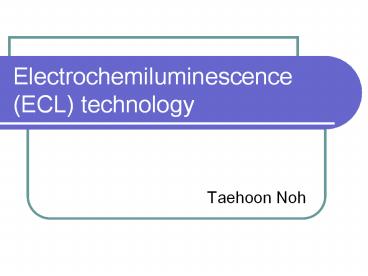Electrochemiluminescence (ECL) technology - PowerPoint PPT Presentation
1 / 12
Title:
Electrochemiluminescence (ECL) technology
Description:
Luminescence produced during electrochemical reactions in solutions. ... the emission of light (luminescence) with limited emission of heat as the result ... – PowerPoint PPT presentation
Number of Views:1594
Avg rating:3.0/5.0
Title: Electrochemiluminescence (ECL) technology
1
Electrochemiluminescence (ECL) technology
- Taehoon Noh
2
What is ECL technology?
- Luminescence produced during electrochemical
reactions in solutions. - Similar to chemiluminescence where one/all
reactants are produced electrochemically on the
electrodes. - Reactive species are generated from stable
precursors (i.e., the ECL-active label) at the
surface of an electrode.
3
Chemiluminescence (CL)
- the emission of light (luminescence) with limited
emission of heat as the result of a chemical
reaction. - A B ? Intermediate ? Products
light - The decay of the excited state Intermediate to
a lower energy level is responsible for the
emission of light.
4
Chemiluminescence
5
Electrochemiluminescence
6
Advantages of ECL
- A highly sensitive and selective method. gt
selectivity of bound and unbound fractions can be
based on the ability of labeled species to access
the electrode surface, - No radioisotopes are used.
- Measurement is simple and rapid.
- The labels are extremely stable compared with
those of most other chemiluminescent systems
7
Applications of ECL
- In vitro diagnostics testing.
- DNA-probe assays.
- Enzymatic biosensors.
8
IGEN vs. Roche
- In 1992, IGEN entered into a technology licensing
agreement with Boehringer Mannheim (BM), which
had been sold to Roche Diagnostics. - For IGEN, it meant additional funding in the
amount of 50 million and a 9 percent royalty, as
well as grant-back rights to improvements. - For BM, it meant an exclusive license to an
advanced diagnostic technology in a market it had
yet to penetrate.
9
IGEN vs. Roche contd
- BM notified IGEN that its royalties on the first
10 million in sales equipment was zero. - While the agreement stipulated that the field of
use was restricted to laboratories, BM had been
marketing its products point-of-care facilities,
such as physicians offices. - IGEN had expressly reserved this area for its own
future development.
10
IGEN vs. Roche contd
- Over the course of six years of litigation, IGEN
had been awarded 105 million in compensatory
damages and 400 million in punitive damages by a
jury. - Jury gave IGEN the right to terminate the
agreement and further to have access to much of
Roches own technology. - Eventually, Roche had to purchase IGEN for
approximately 1.5 billion in order to keep the
diagnostic technology in order to service its
nine-thousand customers worldwide.
11
Lesson Learned
- It would first and foremost be important to
ensure that no provisions within the agreement
were overly restrictive. - The future is uncertain when early-stage
technologies are first being developed. - Limiting ones rights to make use of the
technology in fields yet to be established should
be avoided.
12
Thank you.































